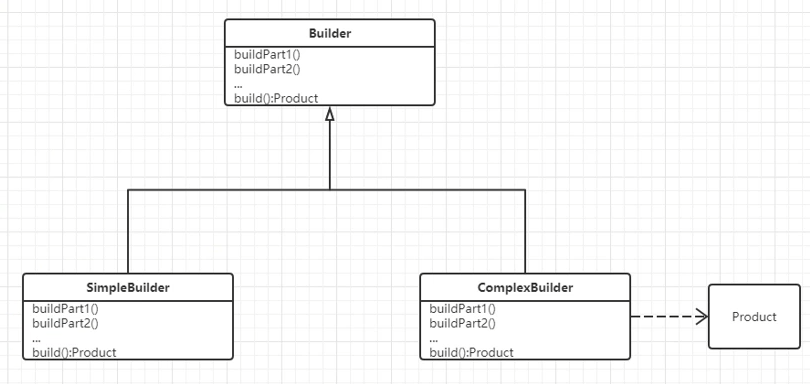- 构建复杂对象
- 分离复杂对象的构建和表示
- 同样的构建过程可以创建不同的表示(Simple和Complex)
- 无需记忆,自然使用(面向对象的思想)
- 与模板方法非常像,模板方法强调的是方法执行,而构建器强调的是对象构建(创建)
- 构建器模式与工厂模式的区别
UML类图

实现
- 先要有一个初始化对象
- 再一步一步地去构建里面的成员属性
- 最后返回构建完毕的对象
- 链式编程(编程简单),builder经常和这种编程方式一起用
- 将Builder作为所构建类的内部静态类并将构造方法设为private—->别人new不了Person,只能通过内部静态类来构建Person,相当于是静态工厂
- 可以指定对象的某一个部分,用不到的用不着每次都传
- 最后的build();拿到最终定制的对象
地形类
``` package com.mashibing.dp.builder;
// 地形 public class Terrain { // 墙 Wall w; // 堡垒 Fort f; // 地雷 Mine m; }
class Wall { int x, y, w, h;
public Wall(int x, int y, int w, int h) {this.x = x;this.y = y;this.w = w;this.h = h;}
}
class Fort { int x, y, w, h;
public Fort(int x, int y, int w, int h) {this.x = x;this.y = y;this.w = w;this.h = h;}
}
class Mine { int x, y, w, h;
public Mine(int x, int y, int w, int h) {this.x = x;this.y = y;this.w = w;this.h = h;}
}
<a name="DEwjK"></a>### 构建器接口
package com.mashibing.dp.builder;
public interface TerrainBuilder { TerrainBuilder buildWall(); TerrainBuilder buildFort(); TerrainBuilder buildMine(); Terrain build(); }
<a name="wiKH8"></a>### 复杂构建器实现
package com.mashibing.dp.builder;
public class ComplexTerrainBuilder implements TerrainBuilder { Terrain terrain = new Terrain();
@Overridepublic TerrainBuilder buildWall() {terrain.w = new Wall(10, 10, 50, 50);return this;}@Overridepublic TerrainBuilder buildFort() {terrain.f = new Fort(10, 10, 50, 50);return this;}@Overridepublic TerrainBuilder buildMine() {terrain.m = new Mine(10, 10, 50, 50);return this;}@Overridepublic Terrain build() {return terrain;}
}
<a name="shfZg"></a>### 构建器作为静态内部类- 没有接口只有类- 没有多种多样的实现类(即只有一种方式的构建器)
package com.mashibing.dp.builder;
public class Person { int id; String name; int age; double weight; int score; Location loc;
private Person() {}public static class PersonBuilder {Person p = new Person();public PersonBuilder basicInfo(int id, String name, int age) {p.id = id;p.name = name;p.age = age;return this;}public PersonBuilder weight(double weight) {p.weight = weight;return this;}public PersonBuilder score(int score) {p.score = score;return this;}public PersonBuilder loc(String street, String roomNo) {p.loc = new Location(street, roomNo);return this;}public Person build() {return p;}}
}
class Location { String street; String roomNo;
public Location(String street, String roomNo) {this.street = street;this.roomNo = roomNo;}
}
<a name="vO7Go"></a>### 使用
package com.mashibing.dp.builder;
public class Main { public static void main(String[] args) { TerrainBuilder builder = new ComplexTerrainBuilder(); Terrain t = builder.buildFort().buildMine().buildWall().build(); //new Terrain(Wall w, Fort f, Mine m) //Effective Java
Person p = new Person.PersonBuilder().basicInfo(1, "zhangsan", 18)//.score(20).weight(200)//.loc("bj", "23").build();}
} ```
有必要吗?为什么不用带参的构造方法?
- 可以用带参的构造方法,没问题,都可以实现
- 但是用这个模式主要是针对参数非常多的时候
- 《Effective Java》构建复杂对象建议用构建器模式
随想
- 静态内部类可以访问外部类的私有成员方法和变量
- 静态内部类初始化的方法、嵌套类的初始化方法

